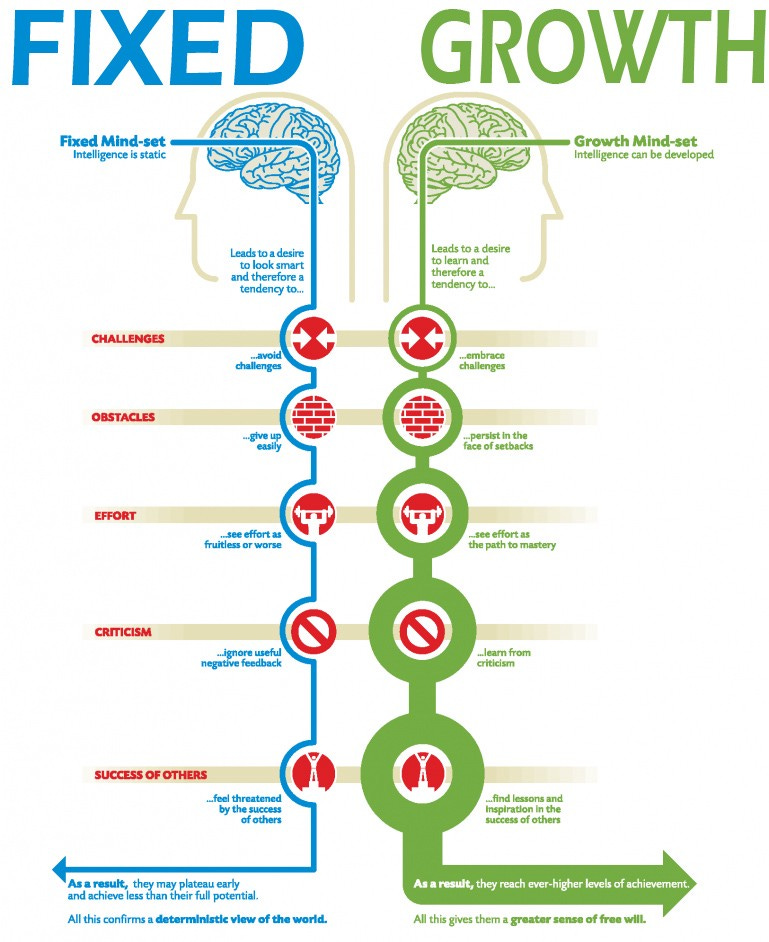A Growth Mindset for Students and Teachers
A lifetime skill to gift our students, and ourselves.

Fact: students who have a growth mindset outperform students who don’t.
Another fact: you can help develop a growth mindset for students (and develop one yourself while you’re at it). Growth mindset and fixed mindset are terms for how we perceive and deal with failure.
If you have a growth mindset, you believe you’re able to learn and improve your skills and knowledge; if you have a fixed mindset, you believe the opposite.
This picture sums it up quite nicely:
These mindsets should be considered on a continuum, with some people having a fixed mindset about some aspects of life and a growth mindset about others, to varying degrees.
The idea of these two mindsets first came about 30 years ago with Carol Dweck, a researcher who wrote the book Mindset: How You Can Fulfil Your Potential. She found that students with a growth mindset had higher motivation levels, and continued to work hard when they failed at a task.
A growth mindset is a powerful tool to give to our students, trainees and staff, as well as develop ourselves. Imagine the difference you could make, not just in your students’ academic performance but in their lives.
How to Develop and Foster a Growth Mindset
Note: this applies equally to teachers, trainers and managers. When I say ‘learner’ below, you can think of your students, your trainees or your staff, as appropriate.
Identify which of your learners have a growth mindset and which have a fixed mindset for the skill you’re helping them to learn.
There are several ways you can help your learners move away from a fixed mindset and towards a growth mindset, in order of difficulty:
1. Praise the Process, Not the Outcome
Studies by Dweck found that praising the process (i.e. “You’ve worked very hard on this”) developed a growth mindset, compared to praising the outcome (i.e. “You’re very smart”). If you praise an aspect the learner can control, they feel they have more autonomy and resilience.
Hey, you could even use catchphrases to remind them (‘It’s not the winning, it’s the taking part… it’s the effort, not the victory…it’s the process, not the outcome’). Use discretion, though — these are more likely to work with younger learners than cynical older TEFL teachers.
2. Teach Learners about Mindsets
Actively make learners aware of the growth and fixed mindset paradigm — show them studies of what a mindset shift can accomplish of how it will impact them and their future. Go all ‘motivational-speaker-Tony-Robbins’ on them and get them fired up to improve their studies and lives. Being transparent about what you’re doing will earn you respect.
Final Word
This has the potential to change your students’ lives. Not just their language learning journey or even their broader academic study, but how they view and interact with the whole world. You’ve got a powerful tool; use it wisely.
To read more about mindsets, you can get a copy of Carol Dweck’s book here.
See you again in two weeks.
Whenever you're ready, there are three ways I can help you:
1. Learn how to plan better, faster and stress-free with my book Lesson Planning for Language Teachers (90 ratings, 4.5⭐ on Amazon).
2. Develop calm students, a relaxed mind and a classroom full of learning with my book Essential Classroom Management (16 ratings, 4.5⭐ on Amazon).
3. Improve your teaching in five minutes a day with my Reflective Teaching Practice Journal (4 ratings, 4.5⭐ on Amazon).




